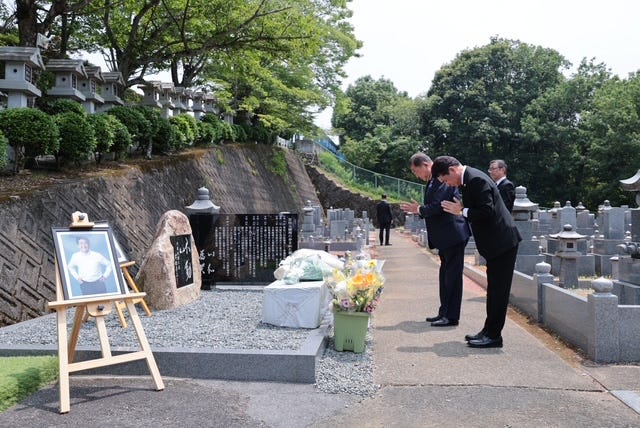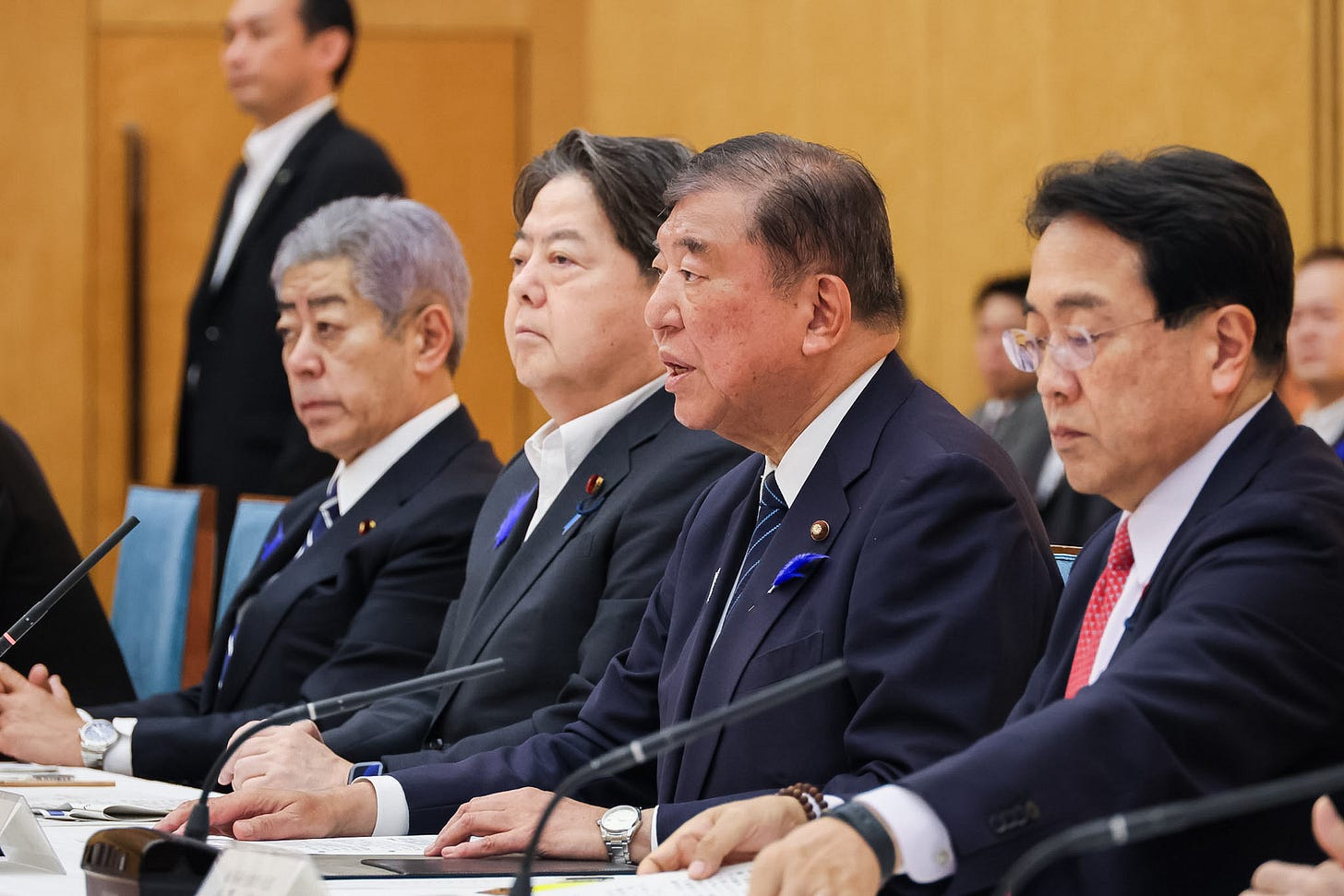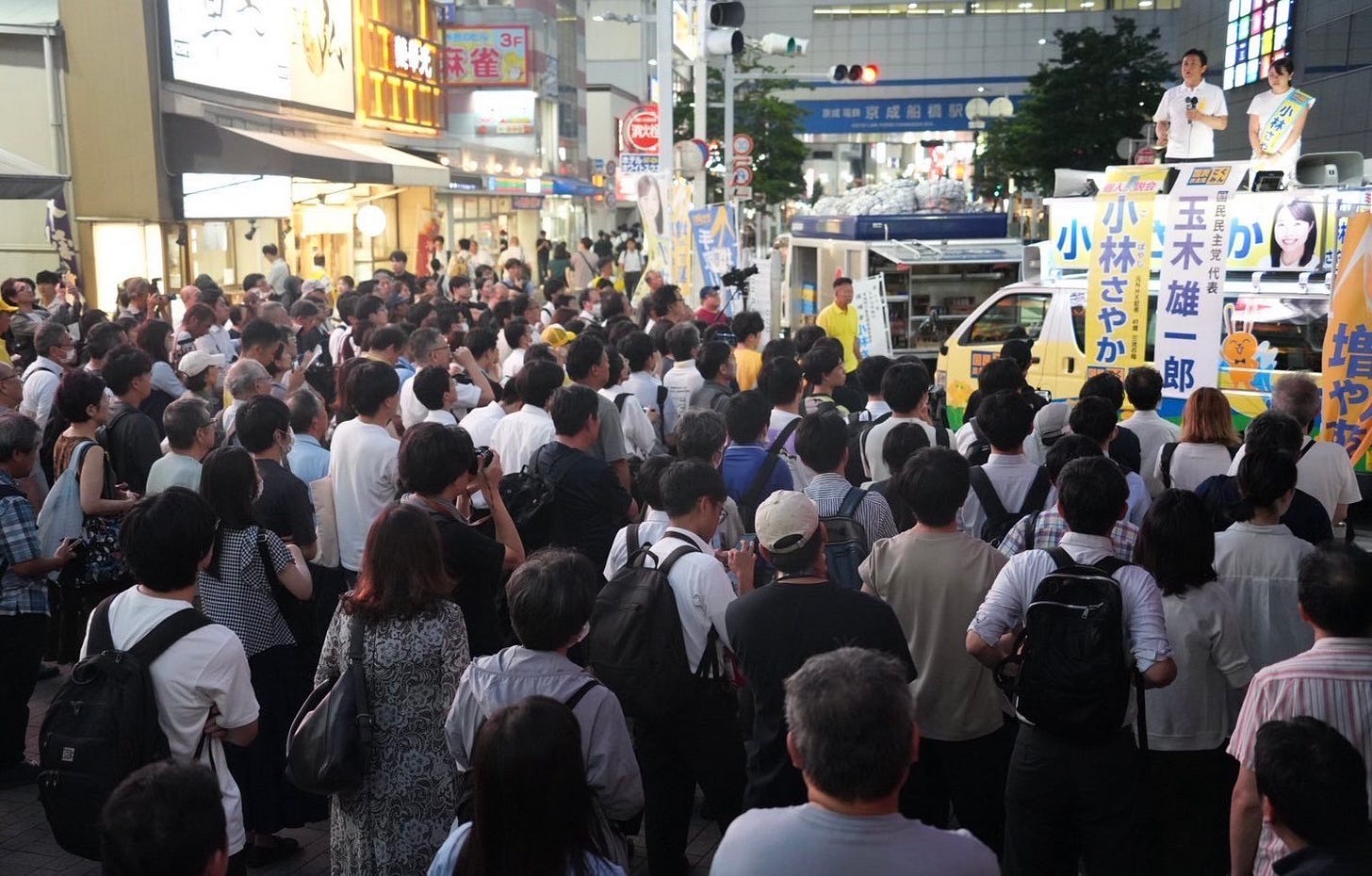Memorial day | Today in the Upper House Campaign
The parties respond to Trump's letter, immigration as a campaign issue, and mixed signals in polling
This is the first of what I expect will be daily coverage of the upper house campaign through election day on 20 July. Today’s edition will be available to all subscribers; subsequent editions will be for paid subscribers only.
Paid subscribers can access my forecast and viewer’s guide here, including information on how to access a conference call on the elections for paid subscribers, which will be held at 9am EDT on 14 July.
A pdf of the report can be purchased here.
If you are looking for timely, forward-looking analysis of the stories in Japans’s politics and policymaking that move markets, I have launched a new service through my business, Japan Foresight LLC. For more information about Japan Foresight’s services or for information on how to sign up for a trial or schedule a briefing, please visit our website or reach out to me.
I also have a new essay at Nikkei Asia discussing what is at stake for Japan in the upper house elections here.
The campaign trail

Prime Minister Ishiba Shigeru was in Nara and Wakayama on Tuesday, 8 July. While in Nara he visited the memorial to Abe Shinzō on the third anniversary of his assassination. Koizumi Shinjirō was in Okinawa. Takaichi Sanae started the day visiting Abe’s grave in Yamaguchi with Abe Akie and then returned to campaign in Nara. Kobayashi Takayuki spent the day in Aomori.
Komeitō’s Saitō Tetsuo was in Yamanashi with one of his party’s proportional representation candidates.
Constitutional Democratic Party (CDP) leader Noda Yoshihiko was in Hokkaido on Tuesday, with stops in Sapporo and Hakodate. CDP Secretary-General Ogawa Junya was in Saitama and Niigata.
Democratic Party for the People (DPFP) leader Tamaki Yūichirō was in Fukui, Ishikawa, Toyama, and Chiba.
Neither Maehara Seiji nor Yoshimura Hirofumi, Ishin no Kai co-leaders, were campaigning on Tuesday.
Sanseitō’s Kamiya Sōhei was in Fukushima, Iwate, and Aomori.
Japanese Communist Party (JCP) leader Tamura Tomoko was in Tokushima and Kagawa.
Opinion polls
In NHK’s “trend” poll from two weeks before election day, the Ishiba government’s approval ratings fell slightly to 31%. Meanwhile, 56% say that they will definitely vote – and 6% say that they already voted – higher than the responses to these questions in the 2022 upper house elections.
Kyodo’s trend poll, meanwhile, looks catastrophically bad for the government, including a seven-point drop in support for the government to 25%. At the same time, Kyodo found that the Liberal Democratic Party’s (LDP) support in PR voting is only 18.2%, while Sanseitō climbed to second place, with 8.1%, ahead of both the DPFP and the CDP. Meanwhile, opposition party candidates are favored by a 36.6% to 20.5% margin in constituency races. The poll found, however, that roughly 40% of respondents are still undecided for both their PR and constituency votes.
News outlets are restricted from publishing polling on specific races, leading them to publish broad outlines. In Mainichi, they project that the LDP will win at least 12 PR seats, but could fall short of the 18 they won last time; the CDP will win at least 8 and is aiming for double digits; and the DPFP will win at least 6. Meanwhile, the paper projects that the LDP has commanding leads in only 9 of 32 single-member constituencies, while the opposition candidates are ahead in 16.
Policy

After US President Donald Trump informed the Japanese government that he would impose 25% “reciprocal” tariffs on Japan starting 1 August, Prime Minister Ishiba hosted a meeting with cabinet ministers to discuss the government’s next steps, as it assesses the potential impact of the tariffs and considers measures to help businesses cope with the new trade barriers. Chief trade negotiator Akazawa Ryōsei confirmed that talks would continue following the Trump administration’s announcement that Japan would face 25% “reciprocal” tariffs from 1 August, and stressed that the reason why no agreement had been reached was because the Ishiba government was defending the national interest without yielding.
Opposition party leaders attacked the Ishiba government for its handling of the negotiations. In a video posted on X, CDP leader Noda lamented that the talks had not gone well and suggested that Ishiba should replace Akazawa Ryōsei as his chief negotiator. Ishin no Kai leader Yoshimura Hirofumi again criticized Ishiba for failing to build a good rapport with Trump and called for relief for automakers, though Ishin no Kai also called for a multi-party organization to ensure the government’s approach is steadfast, regardless of the results of the upper house elections. Finally, the DPFP’s Tamaki Yūichirō declared that the talks had “effectively broken down” and said that this is why his party’s approach to economic stimulus must be adopted.
The LDP’s internal divisions in one chart: Nikkei surveyed upper house candidates and found that while 40% of LDP candidates support the Ishiba government’s – and the LDP manifesto’s – position on keeping consumption taxes unchanged, 43% of LDP candidates want to either reduce the tax on foodstuffs (32%) or reduce or eliminate the tax across the board (11%). Even the CDP, which had its own debate on how to approach the consumption tax question, is more united than the LDP. The LDP is also at odds with its coalition partner Kōmeitō, as 70% of its candidates support reducing the tax on foodstuffs and none want to keep the tax unchanged. The division between proponents and opponents of cutting consumption taxes within the LDP likely maps on to the broader division between conservatives and moderates (or reformists), as suggested by criticism of Ishiba by leading conservative Hagiuda Kōichi, who told a party meeting in Ishikawa prefecture on Monday that the government’s policies had failed to win the public’s support. The intra- and inter-party divisions measured here point to issues after the election, regardless of the outcome. If Ishiba has to resign, the LDP’s leadership fight will likely bitter; if he survives, he likely faces a difficult process of moving a supplemental budget through the Diet.
Sanseitō and other parties are competing to propose restrictions on the inflow of foreign workers workers and control the foreign population already settled in Japan, as Japan’s foreign population has become an issue in this campaign. Mainichi suggests that these parties are competing for the votes of conservatives disaffected with the post-Abe LDP, which, having pushed for more foreign workers, is constrained in proposing restrictionist measures. That said, Prime Minister Ishiba announced on Tuesday, 8 July that his government would stand up an office in the cabinet secretariat focused on “orderly co-existence” with foreign residents, consistent with the LDP’s manifesto. Meanwhile, in a press conference at the Foreign Correspondents Club of Japan, Sanseitō leader Kamiya not surprisingly said that he has affinities for France’s Rassemblement National, Germany’s AfD, and Britain’s Reform UK, as well as the Republican Party in the US. Amidst this shift, a group of NGOs issued a statement on Tuesday pushing back against anti-foreign sentiment. (Mainichi also spoke with Tokyo University Professor Endō Ken about the emergence of anti-migrant politics in Japan.)
Campaign links
NHK has a useful party-by-party survey of where each party stands on major issues.
The full text of the pre-campaign leaders’ debate, discussed in this post.
Nikkei has a tool to match your views to a political party. Asahi has one too.
Nikkei found that if the consumption tax on foodstuffs were eliminated, it would disproportionately benefit the elderly even as the tax cut is disproportionately favored by the young.
An interview with Sanseitō leader Kamiya Sōhei ostensibly about the party’s internet strategy but which covers the party’s campaign strategy more broadly.
A Sankei reporter notes the growing fear of Sanseitō within the LDP as conservatives reject the party’s post-Abe direction.
In that vein, conservative commentator Sakurai Yoshiko excoriates Ishiba has “unqualified” to lead.
Why the party leaders opened their campaigns where they did.







